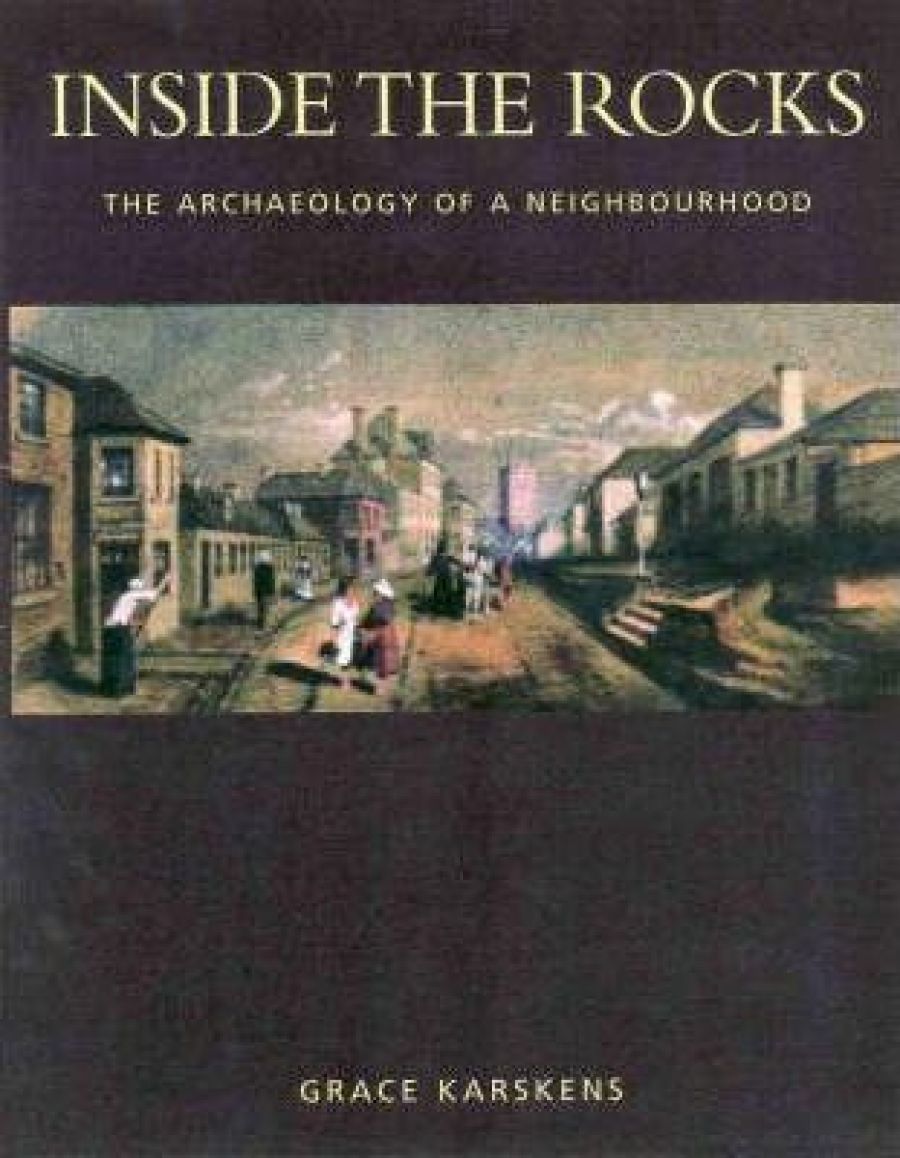
- Free Article: No
- Contents Category: History
- Review Article: Yes
- Online Only: No
- Custom Highlight Text:
On getting hold of Grace Karskens’s new book, I went straight to the colour plates of artefacts resurrected from the neighbourhood of the title, part of the historic Rocks area of inner Sydney. I love to look at salvage: pieced-together dinner plates, dolls’ heads, and brass buckles and buttons whose verdigris defies any amount of elbow grease. But the photo that really grabbed me was of a dug-up gold wedding ring, modelled on one finger of a hand neatly manicured but for a crescent of black dirt embedded deep under the thumbnail. To me, that minute trace of the Rocks neighbourhood spoke vividly – more so, somehow, than any of the scrubbed-up artefacts – of the peculiar joys of dabbling in other people’s cesspits and of the adventure into history that underlies Inside the Rocks.
- Book 1 Title: Inside the Rocks
- Book 1 Subtitle: The archaeology of a neighbourhood
- Book 1 Biblio: Hale & Iremonger, $34.95, 240 pp, 0 868806 666 4
The Cumberland-Gloucester Street excavation (‘the Big Dig’) took place in 1994 on the site of two half-city blocks in one of the first-settled areas of colonial Australia. Supplementing the archaeological team were four hundred volunteers, many with family links to the site. Between them they recovered three-quarters of a million artefacts. Thousands of visitors toured the site to gaze ‘over the ruins of lost Sydney emerging gradually from its grave’.
Grace Karskens was a natural choice for project historian on the Big Dig. An historian and historical archaeologist, she had first researched the site in the mid-1980s, and her PhD thesis on the area’s history (published as The Rocks: Life in Early Sydney, MUP 1997) was well underway. And it is clear that neither the getting of academic credentials nor the ‘often decidedly unglamorous’ practice of archaeology had dulled Karskens’ aliveness to
that sense of connectedness with the past, the immediacy of the physical, the tactile dimension, the recognition that though these generations of people have gone forever, they nevertheless left behind all these places, spaces and things.
With Inside the Rocks, Karskens attempts to knit an historian’s equivalent of the impossible Fair Isle jumper, drawing together the threads of archaeology, genealogy, and oral history, with conventional historical research and a fleck of informed speculation. The abundant historical photos and illustrations are interspersed with shots of some of the ‘buried treasure’ unearthed by the Big Dig. Not just the pretty things and curiosities, but the long-buried stone-flagged floor of the Bird in Hand Hotel and ‘the Byrnes’ magnificent stone cesspit’. The excavated brick and stone footings of the Byrne family home – built c.1807, demolished about 1860 – don’t tell much of a story on their own. (‘Artefacts,’ says Karstens, contesting a popular belief, ‘do not speak for themselves’.) Which is where the skilful knitting comes in. The barebones history of Richard and Margaret Byrne, a convict couple who were among the Rocks’ earliest colonial inhabitants, is enriched by details of ‘the little things’ that fell through their floorboards or were dropped in the yard: lace-making pins, shards of a handsome meat platter, fragments of clay tobacco pipes, children’s marbles and part of a painted doll.
The early chapters, with their insights into individual houses and occupants, go some way towards delivering on the cover blurb’s promise of a ‘fascinating narrative’ and the publishers’ claim that Inside the Rocks is ‘[b]etter than a soap opera’. The details of inner-city living before the advent of the garbo and the night-soil man are splendidly sordid. Archaeologist were not surprised (were pleased, in fact) to find that early householders stashed their rubbish in the shallow space under the floor. But a couple of gruesome discoveries revealed that even deceased pets (specifically, ‘medium-sized dogs’) were disposed of in this way. It doesn’t bear thinking about.
In the second half of the book, Karskens has been less successful at adapting her project report for a general readership. Later chapters address the broader questions posed by the Big Dig’s project brief: the impact of the Industrial Revolution, women’s lives and experiences, and challenging the historical reputation of Rocks people as low life. To a large degree, Karskens’ insistent and drawn-out examination of these questions carries the reader away from the lively specifics of people, place, and artefact to the upholstered generalities of a more scholarly style of writing. The chapter ‘Women and Men, Home and Work’ seems especially doctrinaire, with its re-stressing of the important role of women in shaping the neighbourhood. Having already encountered the likes of Margaret Byrne, Sophia Cribb, and other Rocks women, readers hardly need to be told that, ‘It is clear that many women on the site worked to support themselves and their families.’ In paying penance to theory, Karskens risks shouting down the voices from inside the Rocks and reburying their artefacts.
What Grace Karskens has attempted with Inside the Rocks – the pulling together of the too many threads presented by just one neighbourhood’s history – is marvellous. What she has achieved is impressive, but falls short of the promised good read and presents a view of the Rocks that is more outside-in than inside-out. And the story of the Big Dig itself remains to be told, perhaps by one of those four hundred volunteers with grit still under their nails.


Comments powered by CComment